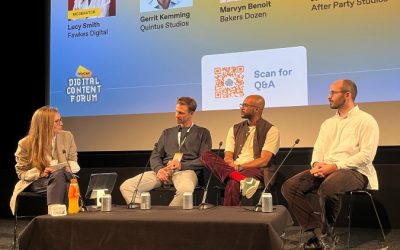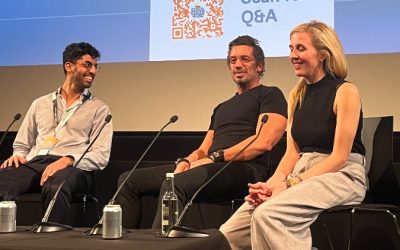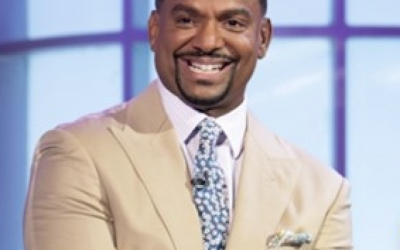When news is breaking, audiences turn to social and online-video platforms… so what does that mean for major media companies in the space?
The closing panel at TellyCast’s Digital Content Forum 2025 in London this week looked at financial, editorial and technological shifts shaping video news. Sam Barcroft of SWNS Media Group / Creatorville moderated the discussion with Sky News’ Kate Sullivan, ITN’s Ian Rumsey and The Sun’s Jon Lloyd.
Lloyd talked about the work that has been going on at The Sun to rethink how it operates. “That means going into every single desk, every single department, and putting video at the heart of everything we do,” he said. “You’ve got to have a diverse portfolio of revenue streams… We have to innovate.”
This has involved shaking up how The Sun publishes news, how its audience and data department operates, and how its commercial department sells ads. The payoffs can be considerable however: Lloyd said that spinning out its royal-family videos into their own YouTube channel tripled revenues in just three weeks.
Sky News is also evolving in response to digital-first trends. “We are reorganising our entire newsroom to look at video first and digital first,” said Sullivan. “We want to be the luxury brand in terms of video. There are some new entrants and we’ve got competition, but we’ve got a newsroom full of experts in video – so we should use them!”
The shift is to thinking about digital-video content as something that “shouldn’t be a traditional TV package: it should look like something the digital audience can understand”. However, Sullivan noted that Sky News is also “getting used to the idea that this can also run on TV… it’s not a typical TV package, but it works.”
Rumsey said that the incentives to rethink the news production processes are clear, saying that digital is “no longer a luxury or a ‘nice to have’, it’s a necessity. You’ve got to do it. We have to do it to make money, we have to do it because it’s logical, and we have to do it from a reputational point of view.”
However, none of this requires ditching the core values of a newsroom, he stressed. “The platforms change but the principles don’t.”
News is one of the media sectors that is facing huge challenges from the emergence of GenAI technologies, from debunking misinformation that spreads online through to changes to the news workflow – and worries that this will put humans out of work.
“It’s so exciting,” said Sullivan about AI’s potential. “But at the same time, it’s not going to replace humans. We believe in humans absolutely. They are going to be the arbiter of what we put out, ultimately.”
The Sun uses AI for some tasks already: for example automating the transcription of videos, with journalists (human ones!) then turning those transcripts into stories.
“Careful is the watchword,” said Lloyd of The Sun’s approach. “As trusted sources I suspect we adopt it slower and with a lot more caution… if you are trusted, play to your strengths, which is that people come to you because they trust you have the authenticity and experience.”
He also talked about another challenge for traditional news media: that a growing number of people – especially younger demographics – get their news from sources on social media rather than big broadcasters. The Sun is responding to this, however.
“We’re growing our journalists with a much stronger social media presence. So if you want your showbiz news, or politics news, or a financial report, our journalists are found on TikTok or Insta or wherever you want to get your news,” said Lloyd.
Collaborations are core to the creator economy, but they can also be part of the news sphere – including outlets you might think of as rivals working together. One recent example was documentary Madeleine McCann: The Unseen Evidence, which The Sun and Channel 4 (via ITN) worked on together.
Each cut their own version of the documentary, with Channel 4’s premiering on TV, and The Sun’s on its own website, YouTube and other social-media platforms. Lloyd and Rumsey agreed that this may be a pointer to future collaborations of this kind between outlets with different tones and audiences, but likeminded investigative nous.
Rumsey warned the traditional news world not to underestimate the skills required to be successful in the digital world.
“If you want to start digital channels or want to expand, then you need digital-first people,” he said, criticising the “arrogance and assumption” from some TV execs that they can simply parachute traditional news people into this environment, picking up the necessary skills as they go.
“This is now a sophisticated, maturing space where you need digital-first natives who are going to take you to the next level,” he said. “You can’t bring that assumption and that arrogance to it.”
The panel finished by looking forward to what digital-first news might look like in three years’ time.
“It’s amazing journalists. We’ve got to raise their profiles [to become] news influencers,” said Lloyd. “I suspect there will be a lot more collaboration. We’re having a lot of conversations with content creators… And I suspect we’ll be on four or five more platforms than we are currently – and I suspect that half of those platforms haven’t even come out yet.”
Rumsey was optimistic. “There will always be a place for news, for people to find out information in a trusted, authentic way,” he said. However, he said he’s most excited because he doesn’t know exactly how this future will look.
“You can trial and test and change things,” he added. “You can tweak and change constantly. If it doesn’t work, do something else. If it does work, do more of it!”
Sullivan agreed with that. “Test and learn,” she said, reiterating the need for “premium, original journalism” with an extra reminder: “The ‘original’ bit is what AI can’t do…”





